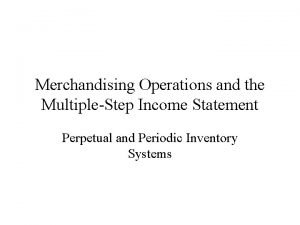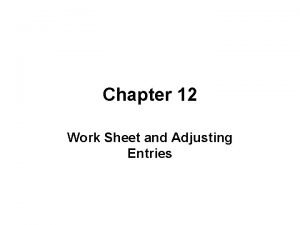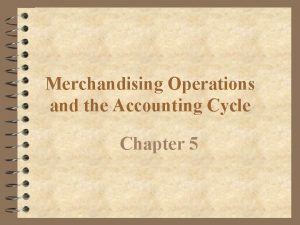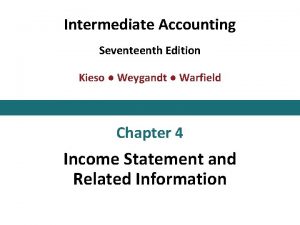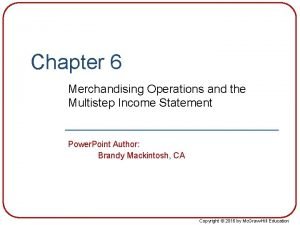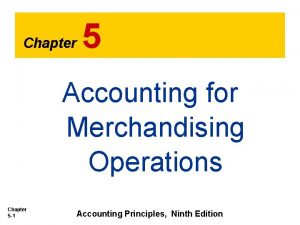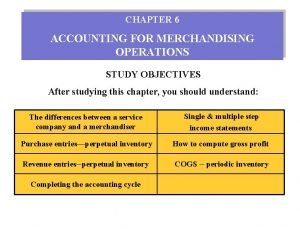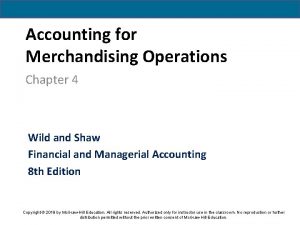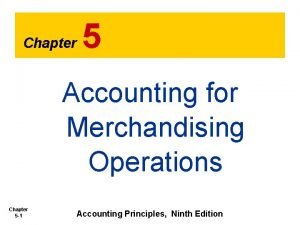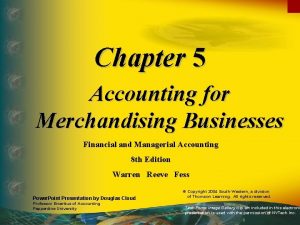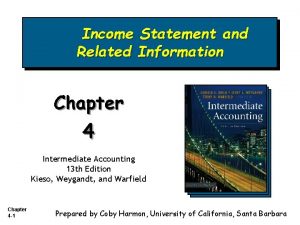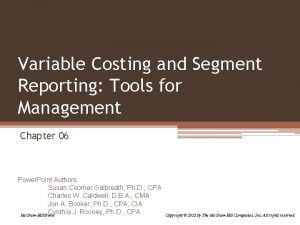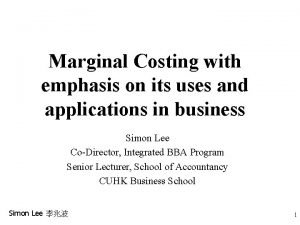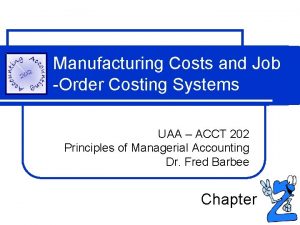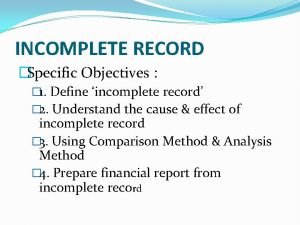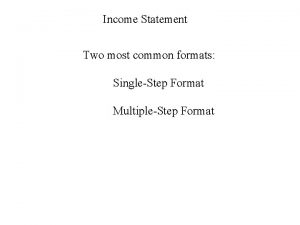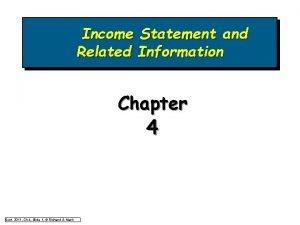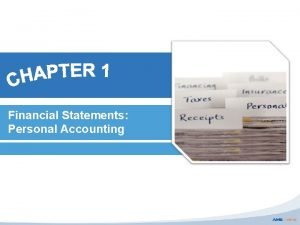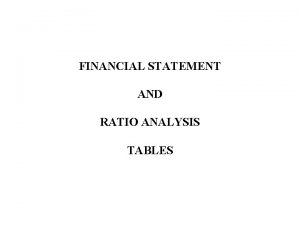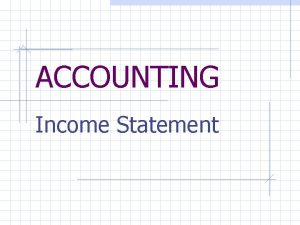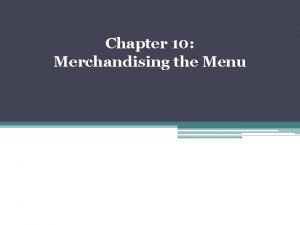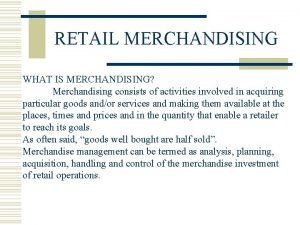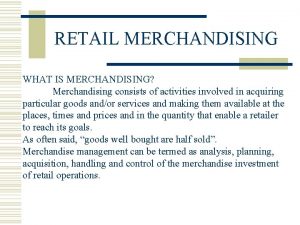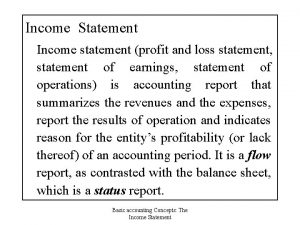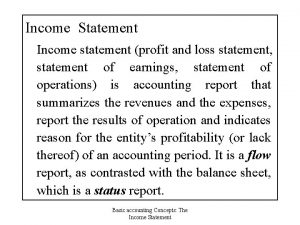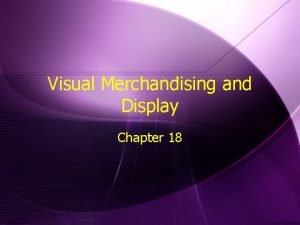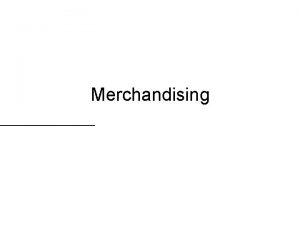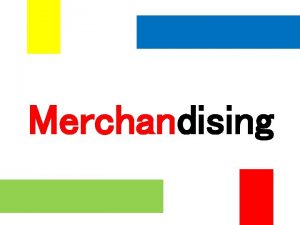5 MERCHANDISING OPERATIONS AND THE MULTIPLESTEP INCOME STATEMENT





































- Slides: 37

5 MERCHANDISING OPERATIONS AND THE MULTIPLE-STEP INCOME STATEMENT 5 -1 Accounting, Fifth Edition

Learning Objectives After studying this chapter, you should be able to: 1. Identify the differences between a service company and a merchandising company. 2. Record a sales transaction (purchase and returns) from BOTH the buyer and the seller under a perpetual inventory system. 3. Explain the recording of purchases under a perpetual inventory system (freight costs, discounts) 4. Distinguish between a single-step and a multiple-step income statement. * (slides 23 -32) 5. Explain the factors affecting profitability. (slides 34 -37) *Self-study 5 -2

Merchandising Operations Merchandising Companies Buy and Sell Goods Retailer Wholesaler Consumer The primary source of revenues is referred to as sales revenue or sales. 5 -3 LO 1 Identify the differences between service and merchandising companies.

Merchandising Operations Income Measurement Sales Revenue Less Cost of Goods Sold Not used in a Service business. Equals Gross Profit Cost of goods sold is the total cost of merchandise sold during the period. 5 -4 Illustration 5 -1 Income measurement process for a merchandising company Less Operating Expenses Equals Net Income (Loss) LO 1 Identify the differences between service and merchandising companies.

Merchandising Operations Operating Cycles Illustration 5 -2 The operating cycle of a merchandising company ordinarily is longer than that of a service company. 5 -5 LO 1 Identify the differences between service and merchandising companies.

Perpetual vs Periodic Inventory Valuations Perpetual l l l 5 -6 Maintain detailed records of the cost of each inventory purchase and sale. Records continuously show inventory that should be on hand for every item. Company determines cost of goods sold each time a sale occurs. Traditionally used for merchandise with high unit values. Shows the quantity and cost of the inventory that should be on hand at any time. Provides better control over inventories than a periodic system. Periodic Does not keep detailed records of the goods on hand. l Cost of goods sold determined by count at the end of the accounting period. l Cost of Goods Sold calculation: l Outdated Beg Inventory Purchases, net Avail for Sale End. Inventory Cost of Goods Sold 100, 000 800, 000 900, 000 125, 000 775, 000

Illustration 5 -5 5 -7 LO 2 Explain the recording of purchases under a perpetual inventory system.

Purchase/Sale of Merchandise On May 14, Sauk Stereo purchased $5, 500 of merchandise inventory on account, credit terms are 2/10, n/30. Buyer Inventory Accounts Payable Seller 3, 800 Accounts Receivable Sales 3, 800 Cost of Goods Sold Inventory 2, 400 3, 800 2, 400 Gross Profit = $1, 400 (3, 800 -2, 400) 5 -8

Recording Purchases of Merchandise Freight Costs – Terms of Sale Illustration 5 -6 Shipping terms Ownership of the goods passes to the buyer when the public carrier accepts the goods from the seller. Ownership of the goods remains with the seller until the goods reach the buyer. Freight costs incurred by the seller are an operating expense. 5 -9 LO 2

Recording Purchases of Merchandise Illustration: Assume upon delivery of the goods on May 6, the BUYER, Sauk Stereo, pays Public Freight Company $150 for freight charges, the entry on Sauk Stereo’s books is: May 6 Inventory 150 Cash 150 Assume the freight terms on the invoice in Illustration 5 -5 had required the SELLER, PW Audio Supply, to pay the freight charges, the entry by PW Audio Supply would have been: May 4 Freight-out expense Cash 5 -10 150 LO 2 Explain the recording of purchases under a perpetual inventory system.

Recording Purchases of Merchandise Purchase Returns and Allowances Purchaser may be dissatisfied because goods are damaged or defective, of inferior quality, or do not meet specifications. 5 -11 Purchase Return Purchase Allowance Return goods for credit if the sale was made on credit, or for a cash refund if the purchase was for cash. May choose to keep the merchandise if the seller will grant a reduction of the purchase price. LO 2 Explain the recording of purchases under a perpetual inventory system.

Merchandise/Sales Return On May 8, Sauk Stereo returns $300 of merchandise. Buyer Accounts Payable Inventory 300 Seller Sales Returns & Allowances* 300 Accounts Receivable 300 Inventory Cost of Goods Sold 140 * Contra-revenue account to Sales Revenue (debit). * Sales not reduced (debited) because it would obscure importance of sales returns and allowances as a percentage of sales. Could distort comparisons. 5 -12 4 -12

Recording Purchases of Merchandise Review Question In a perpetual inventory system, a return of defective merchandise by a purchaser is recorded by crediting: a. Purchases b. Purchase Returns c. Purchase Allowance d. Inventory 5 -13 LO 2 Explain the recording of purchases under a perpetual inventory system.

Ex 5 -1 (1 -4) for BOTH Buyer & Seller, p 262 5 -14

Recording Purchases of Merchandise Purchase Discounts Credit terms may permit buyer to claim a cash discount for prompt payment. Example: Credit terms may read 2/10, n/30. Advantages: u. Purchaser saves money. u. Seller shortens the operating cycle by converting the accounts receivable into cash earlier. Cash is KING! Collect Quick, Pay Slow 5 -15 LO 2 Explain the recording of purchases under a perpetual inventory system.

Recording Purchases of Merchandise Purchase Discounts - Terms 5 -16 2/10, n/30 1/10 EOM n/10 EOM 2% discount if paid within 10 days, otherwise net amount due within 30 days. 1% discount if paid within first 10 days of next month. Net amount due within the first 10 days of the next month. LO 2 Explain the recording of purchases under a perpetual inventory system.

Recording Sales of Merchandise Sales Discount u Offered to customers to promote prompt payment of the balance due. u 5 -17 Contra-revenue account (debit) to Sales Revenue. LO 3 Explain the recording of sales revenues under a perpetual inventory system.

Payment Made/Received w/ Discount Sauk Stereo pays the balance due of $3, 500 (gross invoice price of $3, 800 less purchase returns and allowances of $300) on May 14, the last day of the discount period. Buyer - May 14 Accounts PAYABLE 3, 500 Cash* 3, 430 Merchandise Inventory 70 Seller Cash* 3, 430 Sales Discounts 70 Accounts RECEIVABLE 3, 500 5 -18 4 -18

Payment Made/Received w/ NO Discount Sauk Stereo pays the balance due of $3, 500 (gross invoice price of $3, 800 less purchase returns and allowances of $300) on June 3, AFTER the discount period Buyer - May 14 Accounts PAYABLE Cash* Seller 3, 500 Cash* 3, 500 Accounts RECEIVABLE 3, 500 5 -19 4 -19

Recording Purchases of Merchandise Purchase Discounts Should discounts be taken when offered? Example: 2% for 20 days = Annual rate of 36. 5% $3, 500 x 36. 5% x 20 ÷ 365 = $70 5 -20 LO 2 Explain the recording of purchases under a perpetual inventory system.

Recording Purchases of Merchandise Summary of Purchasing Transactions 4 th - Purchase 6 th – Freight-in $3, 800 150 Balance $3, 580 5 -21 $300 70 8 th - Return 14 th - Discount LO 2 Explain the recording of purchases under a perpetual inventory system.

Ex 5 -1 (5) for BOTH Buyer & Seller, p 262 5 -22

Income Statement Presentation Single-Step Income Statement u Subtract total expenses from total revenues u Two reasons for using the single-step format: 1. Company does not realize any type of profit or income until total revenues exceed total expenses. 2. Form is simple and easy to read. 5 -23 LO 4 Distinguish between a single-step and a multiple-step income statement.

Income Statement Presentation Single. Step Illustration 5 -7 5 -24 LO 4

Income Statement Presentation Multiple-Step Income Statement u Highlights the components of net income. u Three important line items: 1) gross profit, 2) income from operations, and 3) net income. 5 -25 LO 4 Distinguish between a single-step and a multiple-step income statement.

Income Statement Presentation Multiple. Step Illustration 5 -8 Key Line Items 5 -26 LO 4

Multiple. Step Illustration 5 -11 Key Items: u 5 -27 Net sales LO 4

Multiple. Step Illustration 5 -11 Key Items: u Net sales u Gross profit 5 -28 LO 4

Multiple. Step Illustration 5 -11 Key Items: u Net sales u Gross profit u Operating expenses 5 -29 LO 4

Multiple. Step Illustration 5 -11 Key Items: u Net sales u Gross profit u Operating expenses u Nonoperating activities 5 -30 LO 4

Multiple. Step Illustration 5 -11 Key Items: u Net sales u Gross profit u Operating expenses u Nonoperating activities 5 -31 LO 4

Multiple. Step Illustration 5 -11 Key Items: u Net sales u Gross profit u Operating expenses u Nonoperating activities u Net income 5 -32 LO 4

5 -33

Evaluating Profitability Gross Profit Rate May be expressed as a percentage by dividing the amount of gross profit by net sales. A decline in the gross profit rate might have several causes. 5 -34 ► Selling products with a lower “markup. ” ► Increased competition may result in a lower selling price. ► Company forced to pay higher prices to its suppliers without being able to pass these costs on to its customers. LO 6 Explain the factors affecting profitability.

Evaluating Profitability Gross Profit Rate Illustration 5 -15 Why does REI’s gross profit rate differ so much from that of Dick’s Sporting Goods and the industry average? 5 -35 LO 6 Explain the factors affecting profitability.

Evaluating Profitability Profit Margin Ratio Measures the percentage of each dollar of sales that results in net income. How do the gross profit rate and profit margin ratio differ? 5 -36 ► Gross profit ratio - measures a merchandising firm’s ability to earn a profit from the sale of inventory. ► Profit margin ratio - measures the extent by which selling price covers all expenses (including cost of goods sold). LO 6 Explain the factors affecting profitability.

Evaluating Profitability Profit Margin Ratio Illustration 5 -17 How does REI compare to its competitors? Its profit margin was lower than Dick’s in 2010 and was less than the industry average. Thus, its profit margin does not suggest exceptional profitability. 5 -37 LO 6 Explain the factors affecting profitability.
 Perpetual income statement
Perpetual income statement Merchandise inventory adjusting entry
Merchandise inventory adjusting entry Sales discounts income statement
Sales discounts income statement Operating cycle of merchandising business
Operating cycle of merchandising business Total income
Total income Income statement discontinued operations
Income statement discontinued operations Objectives of merchandising
Objectives of merchandising Chapter 6 merchandising activities
Chapter 6 merchandising activities Chapter 5 accounting for merchandising operations
Chapter 5 accounting for merchandising operations Accounting for merchandising operations
Accounting for merchandising operations Chapter 4 accounting for merchandising operations
Chapter 4 accounting for merchandising operations Chapter 5 accounting for merchandising operations
Chapter 5 accounting for merchandising operations Chapter 5 accounting for merchandising operations solutions
Chapter 5 accounting for merchandising operations solutions Chapter 5 accounting for merchandising operations
Chapter 5 accounting for merchandising operations Value added approach
Value added approach Accounting income vs taxable income
Accounting income vs taxable income Accounting income vs taxable income
Accounting income vs taxable income Income statement kieso
Income statement kieso Clifford tse
Clifford tse Is consumable stores on hand an asset
Is consumable stores on hand an asset Marginal costing advantages
Marginal costing advantages Absorption costing income statement
Absorption costing income statement Account title
Account title Revenues minus expenses equals
Revenues minus expenses equals Balance sheet title
Balance sheet title Restaurant pro forma
Restaurant pro forma Another name for income statement
Another name for income statement Marginal cost income statement
Marginal cost income statement Period cost income statement
Period cost income statement Statement of comprehensive income btec business
Statement of comprehensive income btec business Discount allowed in income statement
Discount allowed in income statement Statement of retained earnings
Statement of retained earnings Single step income statement
Single step income statement Accrual accounting
Accrual accounting Hrsuq4wcd0g -site:youtube.com
Hrsuq4wcd0g -site:youtube.com Financial ratio analysis table
Financial ratio analysis table Standardized balance sheet
Standardized balance sheet Commercial bank income statement
Commercial bank income statement
